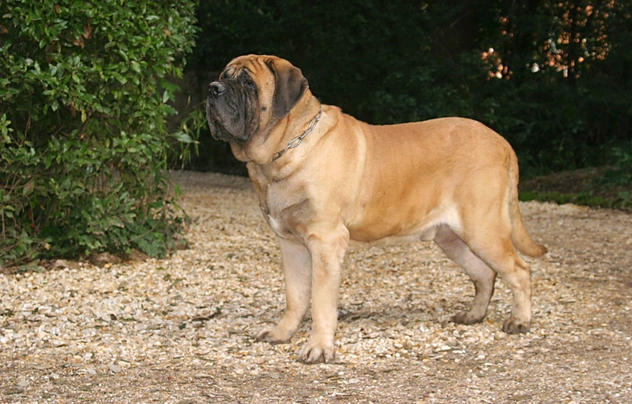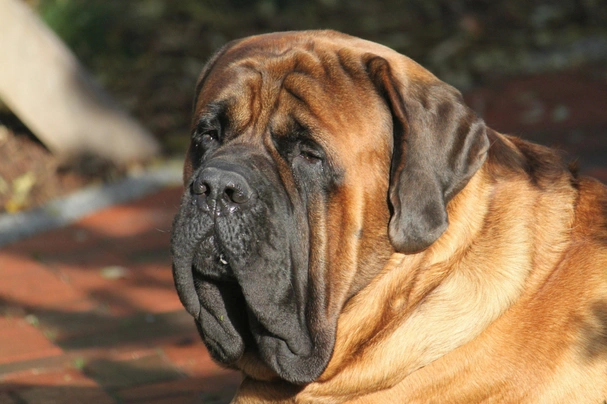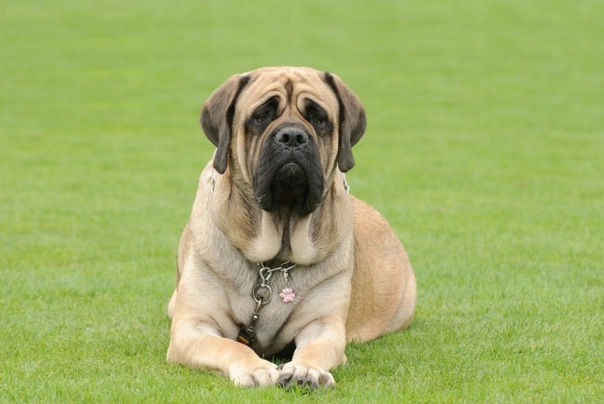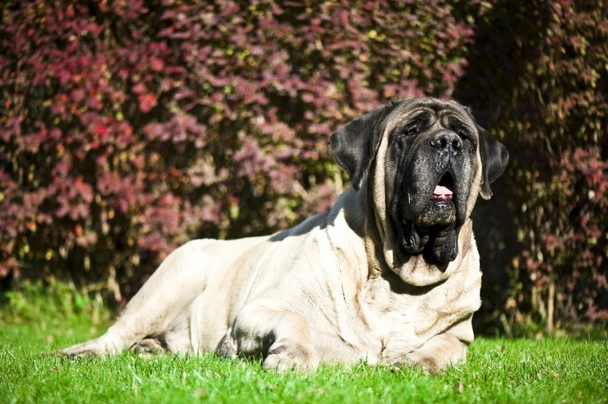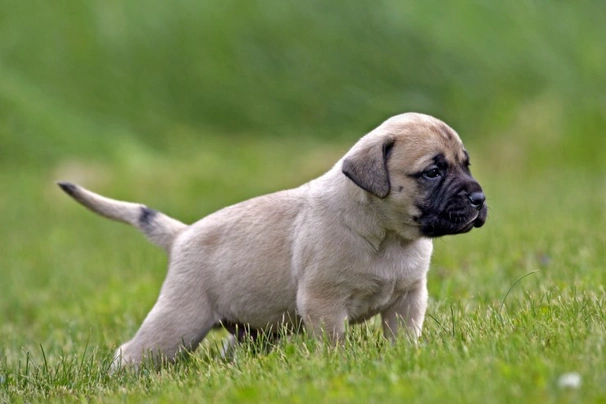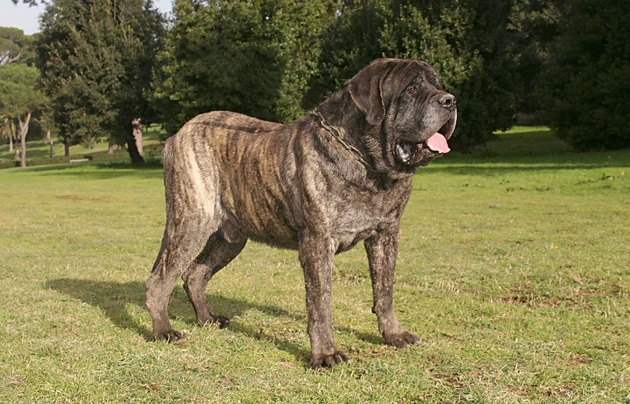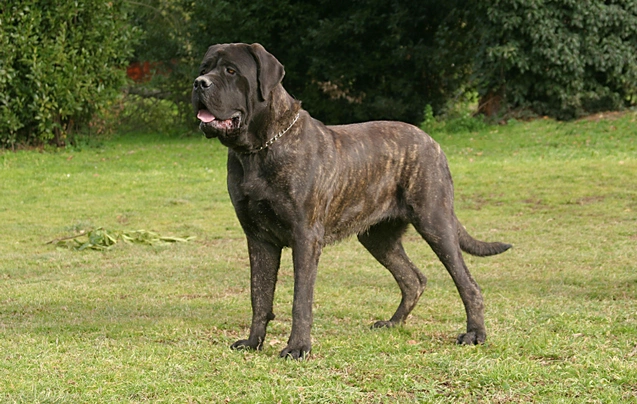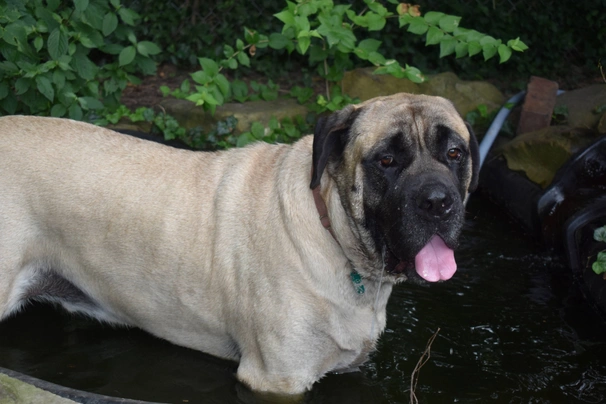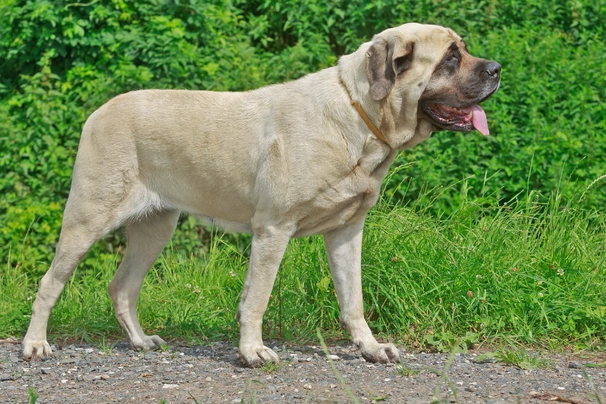Mastiff
Pros
Cons
Introduction of the Mastiff
Mastiffs are large dogs known to be gentle giants. They are highly intelligent and calm by nature loving nothing more than to be in a home environment and involved in everything that goes on around them. They form extremely long bonds with their owners which in short means they thrive on human contact and as such are best suited to families where at least one person usually stays at home when everyone else is out of the house. They are also often referred to as English Mastiffs and thanks to their sheer size they need lot of space both indoors and outside so they can express themselves freely.
Mastiffs need to be given enough mental stimulation and daily physical exercise to keep them fit and healthy because they are prone to put on weight a little too easily. They are not the best choice for first time dog owners because they need to be handled and trained correctly from a young age because when mature they are incredibly strong and could easily pull owners about when the mood takes them.
History of the Mastiff
Mastiffs are among the most ancient breeds around although the dogs we see today are not the same as those seen centuries ago. There are records of the breed that date back to the 15th century when they were used to guard and protect with Babylonian sculptures of similar looking dogs having been discovered. However the actual origins of the Mastiff remain a bit of a mystery. With this said it is thought these large impressive dogs originate from Asia and that it was the Phoenician traders who introduced them to other parts of the world and that when the Romans arrived on Britain's shores they were so impressed by the dogs they found they took them back to Rome with them.
The Normans too were impressed by the large dogs they discovered when they conquered the British Isles and there are records of English Mastiffs having been purchased by Gauls who took their dogs into battle with them. As such it is fair to say that extremely large mastiff-type dogs have been around for 2000 years and even longer. When the Romans left Britain people used Mastiffs as guard dog on farms and to watch over livestock. They were known as Bandogs or Tied Dogs during this time and although they were used as guard dogs they also proved to be good hunting dogs too although a law was passed in Norman times that decreed that dogs should have 3 toes cut off from their front feet to stop them from chasing and killing the King's deer.
There is a story of a Knight called Piers Leigh who was mortally wounded during a battle against the French and that his mastiff stood guard over him to prevent anyone from approaching. The mastiff was a female and it is from her that the famous Lyme Hall mastiffs were descendants although the strain eventually died out later in time. The King of England Henry VIII sent Charles V the King of Spain four hundred mastiffs as a gift and they were destined to become fighting dogs. During the Elizabethan era mastiffs were popularly used for bull bear and even lion baiting as well as being the preferred guard dogs of the day.
The decline of "blood sports" over the ensuing years saw a decline in the number of mastiffs to such an extent that their numbers fell dangerously low and many were crossed with other breeds leaving very few pure "specimens" around. Luckily there were certain lines that remained which included Lyme Hall Elvaston Castle and Chatsworth to name three and it was through the efforts of breed enthusiasts back in the day that the mastiff was saved from extinction altogether with Commissioner Thompson of Halifax being one of the main breeders at the time. Today most Mastiffs can trace their ancestry back to the dogs the commissioner bred.
During the first half of the 18th Century there was a lot of debate as to whether dogs should have long or short muzzles which is a discussion that goes on to this day but by the end of the century Mastiffs were being bred as pedigree show dogs as well as watchdogs with the first six dogs being exhibited at a show in 1859. The number of Mastiffs being exhibited rose to 64 by 1871. In 1873 the Kennel Club was established and in 1883 the Old English Mastiff Club was founded with 51 dogs being exhibited at the first dog show the club held in 1890. Breed numbers rose over the ensuing years but their numbers fell drastically at the outset and during the First World War.
The early 1920's and 1930's saw a revival in an interest in the breed with many kennels being established right up until the start of the Second World War a time that saw their number drop so drastically that the Mastiff nearly vanished altogether with only 14 dogs remaining in the UK. Fortunately breeding stock was imported back to the UK from the States and breed enthusiasts set up careful and selective programmes to save the Mastiff from extinction. Slowly breed numbers rose and the quality of dogs also improved with many breeders producing well-bred puppies with fewer hereditary health issues.
Today the Mastiff remains a popular breed not only here in the UK but elsewhere in the world too and thanks to the ongoing dedication of many breed enthusiasts their numbers have risen again and for good reason Mastiffs boast charming natures and the fact they are so loyal and affectionate although anyone wishing to share their home with one of these impressive dogs would need to have enough space to accommodate them.
Interesting facts about the breed
- Is the Mastiff a vulnerable breed? No the Mastiff remains one of the most popular breeds in the UK and elsewhere in the world
- It is thought that Mastiff-type dogs were around in Babylonian times
- They are descendants of the ancient Molosser and Alaunt dogs
- Hannibal had Mastiffs with him when he crossed the Alps
- Mastiffs were taken to the New World on the Mayflower in the late 1800's
- A Mastiff called Zorba held the record for being the largest dog in the world in 1989
Appearance of the Mastiff
Height at the withers: Males 76 - 91 cm Females 70 - 91 cm
Average weight: Males 68 - 113 kg Females 54 - 82 kg
English Mastiffs are impressive looking dogs with large imposing heads that give the impression of being quite square from every view point. They have a very grand look about them with their broad skulls and their flat foreheads that only show any wrinkling when a Mastiff is alert or interested in something that's going on around them. They have well developed cheeks and the muscles on their temples are large too. They have a definite median line between their eyes which adds to their imposing look.
Muzzles are short being broad under a dog's eyes and quite blunt with a good depth from the nose to the under-jaw. Mastiffs have broad noses with wide open nostrils. Their lips are slightly drooping without being excessively so. Their eyes are set wide apart and are moderately large with a well-defined stop between them. Eyes are a dark hazel in colour and their ears are small thin and set wide apart on a dog's head lying close and flat to their cheeks when relaxed. The Mastiff has a strong jaw and powerful teeth.
They have moderately long and very well-muscled slightly arched necks and muscular sloping shoulders. Front legs are strong straight showing a good amount of bone. Chests are deep and wide being well let down and ribs are well rounded and arched. Their backs and loins are extremely well muscled and wide being wider in a female than in their male counterparts. Hindquarters are muscular wide and broad with dogs having powerful back legs with nicely developed second thighs. Feet are round tight and large with well arched toes and black nails. Their tails are set high being wider at the base before tapering to the tip. Mastiffs carry their tails down when relaxed but in a curve with the tip pointing upwards where alert or excited.
When it comes to their coat the Mastiff boasts having a close-lying short coat with the hair being coarser over their shoulders and necks. The accepted breed colours for Kennel Club registration are as follows:
- Apricot fawn
- Brindle
- Fawn
Gait/movement
When a Mastiff moves they show a great amount of power while at the same time having a free and easy far reaching gait with plenty of drive coming from their hindquarters covering a lot of ground when they move and showing total soundness.
Faults
The Kennel Club frowns on any exaggerations and departures from the breed standard and would judge faults on how much they affect a Mastiff's overall health and wellbeing as well as their ability to work.
Males should have both testicles fully descended into their scrotums and it is worth noting that dogs can be a little heavier or lighter as well as slightly taller or shorter than stated in the breed standard which is given by the Kennel Club as a guideline only.
Temperament of the Mastiff
The Mastiff may be an imposing looking dog but they are real gentle giants that form strong bonds with their families and owners. They are usually fine around people they don't know to the point of being quite indifferent towards them. However they would quickly defend an owner and their property if a dog felt they were being threatened in any way which in short means Mastiffs do make good watchdogs.
They are best suited to people who are familiar with the needs of such large dogs and in households where one person usually stays at home when everyone else is out of the house. The reason being Mastiffs do not like being left on their own for long periods of time thriving on human contact. Early socialisation is a must for such large dogs because they are a lot easier to handle when young. Their socialisation must include introducing young Mastiffs to lots of new situations noises people other animals and dogs once they have been fully vaccinated so they grow up to be well-rounded relaxed mature dogs in any situation and when they are around other dogs and people.
Their training must start when dogs are still manageable too beginning with the basics as soon as a Mastiff puppy arrives in their new home. As previously mentioned these large dogs form extremely strong bonds with their owners which means they do not do well when left to their own devices for too long which could result in a dog developing separation anxiety.
Mastiffs need to be given the right amount of exercise every day but they also need to have a lot of daily mental stimulation to prevent boredom from setting in which could result in them being destructive around the home which is their way of relieving any stress they may be feeling.
Mastiffs are imposing dogs with impressive appetites which means they are expensive to feed. They are also known to "slobber" a lot which means they are not the best choice of canine companion for house proud people. They also shed quite a bit all year round and a Mastiff's tail can cause a lot of damage when wagged excitedly. It is worth noting that a well-bred Mastiff is even tempered and rarely would a dog display aggressive behaviour. With this said although large and imposing Mastiffs are known to be quite timid by nature and they show this by being aloof and wary of strangers and people they don't already know.
Are they a good choice for first time owners?
Mastiffs are not the best choice for first time dog owners being better suited to people who are familiar with such a large breed as well as their specific needs bearing in mind that they hate being left on their own for any length of time and as such are better suited to households where one person stays at home when everyone else is out or with people who work from home.
What about prey drive?
Mastiffs are highly intelligent and can be trained not to chase other animals and smaller pets. However they do have a high prey drive and if not well socialised and trained from a young enough age a Mastiff will give chase to any animals that attempts to run away. As such care should be taken when they are around animals they don't already know just to be on the safe side.
What about playfulness?
Mastiffs have a playful side to their natures and like playing interactive games with their owners. Puppies must be taught to play nicely because when grown up Mastiffs are powerful strong dogs that could easily knock someone over if playtime gets too rough.
What about adaptability?
Mastiffs are a large breed and therefore they need enough space to express themselves as they should. As such they are not best suited to apartment living and are much happier living in homes with large secure back gardens they can roam around in whenever possible. As such they are not the best choice for people who live in apartments.
What about separation anxiety?
As previously mentioned Mastiffs form very strong ties with their families and are never very happy when they find themselves left on their own for longer or even shorter periods of time. As such they are better suited to people who either work from home or in households where one person stays at home when everyone else is out so they are never alone for any length of time which could see a dog suffering from separation anxiety. This can lead to them being destructive around the home which is a dog's way of relieving any stress they are feeling and a way to keep themselves entertained.
What about excessive barking?
Mastiffs are not known to be "barkers" but this is not to say that a dog would not be quick off the mark to let an owner know when something they don't like is going on around them which includes when there are strangers about. However any dog that's left on their own for long periods could start barking as a way of showing they are unhappy about the situation.
Do Mastiffs like water?
Most Mastiffs like swimming and will take to the water whenever they can more especially when the weather is hot. However if anyone who owns a dog that does not like water should never force them to go in because it would just end up scaring them. With this said care should always be taken when walking a Mastiff off the lead anywhere near more dangerous watercourses just in case a dog decides to leap in and then needs rescuing because they can't get out on their own.
Are Mastiffs good watchdogs?
Mastiffs are natural watchdogs with their size alone being enough to put most wrongdoers from getting onto a property. With this said a well-bred Mastiff will automatically be protective of their families and homes but rarely would they show any sort of aggression when they guard the things they love. Mastiffs do not need to be trained to "guard" which could end up making a dog more aggressive and dominant which is to be avoided at all costs.
Intelligence / Trainability of the Mastiff
The Mastiff is an intelligent dog and they like to please. However their training must start as early as possible when dogs are still manageable size-wise. Their training must be consistent and always fair so that dogs understand what is expected of them. Puppies need to be taught the "basics" as soon as they arrive in their new homes and then once they've had all their jabs it's a good idea to enrol them into puppy classes. Not only is this a great way of socialising a dog but it's a good way to start their education in earnest in a safe and controlled environment around lots of other dogs and people.
Training sessions need to be kept short to begin with and they must be as interesting as possible to keep a puppy or young dog focused on what is being asked of them. Longer more repetitive training sessions make it harder to keep a dog's attention. Being sensitive by nature Mastiffs do not respond well to any sort of harsh correction or heavier handed training methods. They do answer well to positive reinforcement and high value treats which always brings the best out of these impressive looking dogs.
Mastiffs need to know their place in the pack and who is the alpha dog in a household or they may take on the role of dominant dog which is something to be avoided at all costs with such a large and imposing dog. All puppies should be given limits and boundaries because when ground rules are set out dogs understand what their owners expect of them. The first commands a Mastiff puppy should be taught are as follows:
- Come
- Sit
- Stay
- Quiet
- Leave it
- Down
- Bed
Children and other
Mastiffs are laid-back by nature and they enjoy being in a home environment forming strong bonds with their families. However because of their large size they are not the best choice for people with toddlers or younger children just in case they get knocked over albeit by accident. They are a great choice in households where the children are older and who therefore know how to behave and play with such large dogs. With this said Mastiffs that grow up with kids in the home form strong bonds with them and care should always be taken when the children have friends over to play because Mastiffs can be over-protective.
Pets4homes advises that Mastiffs are not the best choice for families with babies or very young children. Anyone who already shares a home with a Mastiff and who have younger children should always make sure they are never left together unattended. It is also crucial for parents to teach young children how to behave around dogs and when to stay away from them particularly when there is food around or during playtime.
They usually get on well with other dogs they meet more especially if a Mastiff has been well socialised from a young enough age. If they grow up with a family cat in a household they usually get on well together but care has to be taken when they are around any other cats small animals and pets just to be on the safe side bearing in mind that if animals run away a Mastiff might give chase more especially if they have not be trained not to because they would see them as fair game.
Health of the Mastiff
The average life expectancy of a Mastiff is between 10 and 12 years when properly cared for and fed an appropriate good quality diet to suit their ages.
Like many other breeds the Mastiff is known to suffer from a few hereditary health issues which are worth knowing about if you are planning share your home with one of these large and imposing dogs. The conditions that seem to affect the breed the most include the following:
- Hip dysplasia - Breeders should have stud dogs hip scored
- Elbow dysplasia - Breeders should have stud dogs tested
- Progressive retinal atrophy - Breeders should have stud dogs eye tested through the Animal Health Trust
- Pyometra
- Wobbler syndrome
- Bone cancer
- Kidney stones
- Allergies
- Canine acne
- Cranial cruciate ligament injury
- Canine cystinuria
- Obesity
- Bloat - gastric torsion
What about vaccinations?
Mastiff puppies would have been given their initial vaccinations before being sold but it is up to their new owners to make sure they have their follow-up shots in a timely manner with the vaccination schedule for puppies being as follows:
- 10 -12 weeks old bearing in mind that a puppy would not have full protection straight away but would be fully protected 2 weeks after they have had their second vaccination
There has been a lot of discussion about the need for dogs to have boosters. As such it's best to talk to a vet before making a final decision on whether a dog should continue to have annual vaccinations which are known as boosters.
What about spaying and neutering?
A lot of vets these days recommend waiting until dogs are slightly older before spaying and neutering them which means they are more mature before undergoing the procedures. As such they advise neutering males and spaying females when they are between the ages of 6 to 9 months old and sometimes even when a dog is 12 months old.
Other vets recommend spaying and neutering dogs when they are 6 months old but never any earlier unless for medical reasons. With this said many breeds are different and it is always advisable to discuss things with a vet and then follow their advice on when a dog should be spayed or neutered.
What about obesity problems?
Some Mastiffs gain weight after they have been spayed or neutered and it's important to keep an eye on a dog's waistline just in case they do. If a dog starts to put on weight it's important to adjust their daily calorie intake and to up the amount of exercise they are given. Older Mastiffs too are prone to gaining weight and again it's essential they be fed and exercised accordingly because obesity can shorten a dog's life by several years. The reason being that it puts a lot of extra strain on a dog's internal organs including the heart.
What about allergies?
Mastiffs are prone to suffering from allergies and it's important for a dog to see a vet sooner rather than later if one flares up. Allergies can be notoriously hard to clear up and finding the triggers can be challenging. With this said a vet would be able to make a dog with an allergy more comfortable while they try to find out the triggers which could include the following:
- Certain foods
- Airborne pollens
- Dust mites
- Environment
- Flea and tick bites
- Chemicals found in everyday household cleaning products
Participating in health schemes
All responsible Mastiff breeders would ensure that their stud dogs are tested for known hereditary and congenital health issues known to affect the breed by using the following schemes:
- BVA/KC Hip Dysplasia Scheme
- BVA/KC Elbow Dysplasia Scheme
- Progressive retinal atrophy - test available through the Animal Health Trust
What about breed specific breeding restrictions?
Apart from the standard breeding restrictions set out for all Kennel Club registered breeds currently there are no further breed specific breeding restrictions set out for the Mastiff.
What about Assured Breeder Requirements?
It is mandatory for all Kennel Club Assured Breeders to have their stud dogs tested using the following scheme:
The Kennel Club also recommends that all Mastiff breeders use the following schemes on all dogs destined to be used for breeding purposes:
- BVA/KC Elbow Dysplasia Scheme
- Bitches under the age of 20 months are not to produce a litter
- Bitches over 6 years should not produce a litter
Caring for the Mastiff
As with any other breed Mastiffs need to be groomed on a regular basis to make sure their coats and skin are kept in top condition bearing in mind that they are very prone to suffering from skin allergies which must be treated sooner rather than later. They also need to be given regular daily exercise to ensure they remain fit and healthy. On top of this dogs need to be fed good quality food that meets all their nutritional needs throughout their lives.
Caring for aMastiff puppy
Mastiff puppies are boisterous and full of life which means it's essential for homes and gardens to be puppy-proofed well in advance of their arrival. A responsible breeder would have well socialised their puppies which always leads to more outgoing confident and friendly dogs right from the word go. With this said any puppy is going to feel vulnerable when they leave their mother and littermates which must be taken into account. The longer a puppy can remain with their mother the better although it should never be for too long either.
It's best to pick a puppy up when people are going to be around for the first week or so which is the time needed for a puppy to settle in. Puppy-proofing the home and garden means putting away any tools and other implements that a boisterous puppy might injure themselves on. Electric wires and cables must be put out of their reach because puppies love chewing on things. Toxic plants should be removed from flowerbeds and the home too.
Puppies need to sleep a lot to grow and develop as they should which means setting up a quiet area that's not too out of the way means they can retreat to it when they want to nap and it's important not to disturb them when they are sleeping. It's also a good idea to keep "playtime" nice and calm inside the house and to have a more active "playtime" outside in the garden which means puppies quickly learn to be less boisterous when they are inside.
The documentation a breeder provides for a puppy must have all the details of their worming date and the product used as well as the information relating to their microchip. It is essential for puppies to be wormed again keeping to a schedule which is as follows:
- Puppies should be wormed at 6 months old
- They need to be wormed again when they are 8 months old
- Puppies should be wormed when they are 10 months old
- They need to be wormed when they are 12 months old
Things you'll need for your puppy
There are certain items that new owners need to already have in the home prior to bringing a new puppy home. It's often a good idea to restrict how much space a puppy plays in more especially when you can't keep an eye on what they get up to bearing in mind that puppies are often quite boisterous which means investing in puppy gates or a large enough playpen that allows a Mastiff puppy the room to express themselves while keeping them safe too. The items needed are therefore as follows:
- Good quality puppy or baby gates to fit on doors
- A good well-made playpen that's large enough for a puppy to play in so they can really express themselves as puppies like to do
- Lots of well-made toys which must include good quality chews suitable for puppies to gnaw on bearing in mind that a puppy will start teething anything from when they are 3 to 8 months old
- Good quality feed and water bowls which ideally should be ceramic rather than plastic or metal
- A grooming glove
- A slicker brush or soft bristle brush
- Dog specific toothpaste and a toothbrush
- Scissors with rounded ends
- Nail clippers
- Puppy shampoo and conditioner which must be specifically formulated for use on dogs
- A well-made dog collar or harness
- A couple of strong dog leads
- A well-made dog bed that's not too small or too big
- A well-made dog crate for use in the car and in the home that's large enough for a puppy to move around in
- Baby blankets to put in your puppy's crate and in their beds for when they want to nap or go to sleep at night
Keeping the noise down
All puppies are sensitive to noise including Mastiff puppies. It's important to keep the noise levels down when a new puppy arrives in the home. TVs and music should not be played too loud which could end up stressing a small puppy out.
Keeping vet appointments
As previously mentioned Mastiff puppies would have been given their first vaccinations by the breeders but they must have their follow up shots which is up to their new owners to organise. The vaccination schedule for puppies is as follows:
- 10 -12 weeks old bearing in mind that a puppy would not have full protection straight away but would only be fully protected 2 weeks after they have had their second vaccination
When it comes to boosters it's best to discuss these with a vet because there is a lot of debate about whether a dog really needs them after a certain time. However if a dog ever needed to go into kennels their vaccinations would need to be
What about older Mastiffs when they reach their senior years?
Older Mastiffs need lots of special care because as they reach their golden years they are more at risk of developing certain health concerns. Physically a dog's muzzle may start to go grey but there will be other noticeable changes too which includes the following:
- Coats become coarser
- A loss of muscle tone
- Mastiffs can either become overweight or underweight
- They have reduced strength and stamina
- Older dogs have difficulty regulating their body temperature
- They often develop arthritis
- Immune systems do not work as efficiently as they once did which means dogs are more susceptible to infections
Older dogs change mentally too which means their response time tends to be slower as such they develop the following:
- They respond less to external stimuli due to impaired vision or hearing
- They tend to be a little pickier about their food
- They have a lower pain threshold
- Become intolerant of any change
- Often an older dog can feel disorientated
Living with a Mastiff in their golden years means taking on a few more responsibilities but these are easily managed and should include rethinking a dog’s diet the amount of exercise they are given how often their dog beds need changing and keeping an eye on the condition of their teeth.
Older dogs need to be fed a good quality diet that meets their needs at this stage of their lives all the while keeping a close eye on a dog's weight. A rough feeding guide for older Mastiffs is as follows bearing in mind they should be fed highly digestible food that does not contain any additives:
- Protein content should be anything from 14 – 21%
- Fat content should be less than 10%
- Fibre content should be less than 4%
- Calcium content should be 0.5 – 0.8%
- Phosphorous content should be 0.4 – 0.7%
- Sodium content should be 0.2 – 0.4%
Older Mastiffs don't need to be given the same amount of daily exercise as a younger dog but they still need the right amount of physical activity to maintain muscle tone and to prevent a dog from putting on too much weight. All dogs need access to fresh clean water and this is especially true of older dogs when they reach their golden years because they are more at risk of developing kidney disorders.
Grooming of the Mastiff
Mastiffs have close lying short coats and as such they are low maintenance on the grooming front. A weekly brush and wipe over with a chamois leather is all it takes to keep their coats in good condition. However they shed steadily throughout the year only more so during the Spring and then again in the Autumn when more frequent brushing is usually necessary to remove any loose and shed hair from a dog's coat.
It's also important to check a dog's ears on a regular basis and to clean them when necessary. If too much wax builds up in a dog's ears it can lead to a painful infection which can be hard to clear up. In short prevention is often easier than cure when it comes to ear infections.
Exercise of the Mastiff
Mastiffs are intelligent and although not high energy dogs they need to be given the right amount of daily exercise combined with enough mental stimulation for them to be truly happy well-rounded dogs. They need a minimum of 1 hour's exercise a day with as much off the lead time as possible. If they are not given the right amount of mental stimulation and exercise every day a Mastiff would quickly get bored and could even begin to show some destructive behaviours around the home which is their way of relieving any stress they may be feeling.
A shorter walk in the morning would be fine but a longer more interesting one in the afternoon is a must. These dogs also like to be able to roam around a back garden as often as possible so they can really let off steam. However the fencing must be extremely secure to keep these large and impressive dogs in because if they find a weakness in the fence they will soon escape out and get into all sorts of trouble.
With this said Mastiff puppies should not be over exercised because their joints and bones are still growing. This includes not letting a dog jump up and down from furniture or going up or down the stairs. Too much pressure placed on their joints and spines at an early age could result in a dog developing serious problems later in their lives.
Feeding of the Mastiff
If you get a Mastiff puppy from a breeder they would give you a feeding schedule and it's important to stick to the same routine feeding the same puppy food to avoid any tummy upsets. You can change a puppy's diet but this needs to be done very gradually always making sure they don't develop any digestive upsets and if they do it's best to put them back on their original diet and to discuss things with the vet before attempting to change it again.
Older dogs are not known to be fussy eaters but this does not mean they can be fed a lower quality diet. It's best to feed a mature dog twice a day once in the morning and then again in the evening making sure it's good quality food that meets all their nutritional requirements. It's also important that dogs be given the right amount of exercise so they burn off any excess calories or they might gain too much weight which can lead to all sorts of health issues. Obesity can shorten a dog's life by several years so it's important to keep an eye on their waistline from the word go.
Because Mastiffs are known to suffer from bloat it is very important for them to be fed twice a day instead of giving a dog one larger meal a day. It's also a good idea to invest in a stand for their feed bowls which makes it easier for these large dogs to eat comfortably without having to stretch their necks down to reach their food. Dogs should never be exercised just before or just after they have eaten either because this puts them more at risk of suffering from gastric torsion. Bloat is an extremely serious condition that can prove fatal and veterinary attention should be sought immediately if a dog shows any signs of suffering from gastric torsion.
Feeding guide for a Mastiff puppy
Puppies need to be fed a highly nutritious good quality diet for them to develop and grow as they should. As a rough guide a Mastiff puppy can be fed the following amounts every day making sure their meals are evenly spread out throughout the day and it's best to feed them 3 or 4 times a day:
- 2 months old - 319g to 547g depending on puppy's build
- 3 months old - 416g to 730g depending on puppy's build
- 4 months old - 459g to 809g depending on puppy's build
- 5 months old - 544g to 972g depending on puppy's build
- 6 months old - 617g to 1104g depending on puppy's build
- 7 months old - 619g to 1124g depending on puppy's build
- 8 months old - 615g to 1129g depending on puppy's build
- 9 months old - 567g to 1293g depending on puppy's build
- 10 months old - 531g to 1248g depending on puppy's build
- 11 months old - 486g to 1011g depending on puppy's build
- 12 months old - 444g to 961g depending on puppy's build
- 13 months old - 441g to 904g depending on puppy's build
- 14 months old - 436g to 851g depending on puppy's build
Once a puppy is 18 months old they can be fed adult dog food.
Feeding guide for an adult Mastiff
Once fully mature an adult Mastiff must be fed a good quality diet to ensure their continued good health. As a rough guide an adult Mastiff can be fed the following amounts every day:
- Dogs weighing 54 kg can be fed 458g to 519g depending on activity
- Dogs weighing 68 kg can be fed 519g to 683g depending on activity
- Dogs weighing 82 kg can be fed 635g to 836g depending on activity
- Dogs weighing 113 kg can be fed 739g to 984g depending on activity
Mastiff price
If you are looking to buy a Mastiff you would need to pay anything from £350 to over £1000 for a well-bred pedigree puppy. The cost of insuring a male 3-year-old Mastiff in northern England would be £61.92 a month for basic cover but for a lifetime policy this would set you back £128.31 a month (quote as of February 2018). When insurance companies calculate a pet's premium they factor in several things which includes where you live in the UK a dog's age and whether they have been neutered or spayed among other things.
When it comes to food costs you need to buy the best quality food whether wet or dry making sure it suits the different stages of a dog’s life. This would set you back between £80 - £90 a month. On top of this you need to factor in veterinary costs if you want to share your home with a Mastiff and this includes their initial vaccinations their annual boosters the cost of neutering or spaying a dog when the time is right and their yearly health checks all of which quickly adds up to over £1500 a year.
As a rough guide the average cost to keep and care for a Mastiff would be between £150 to £210 a month depending on the level of insurance cover you opt to buy for your dog but this does not include the initial cost of buying a well-bred healthy Kennel Club registered pedigree Mastiff puppy.
Buying advice
When visiting and buying any puppy or dog there are many important things to consider and questions to ask of the breeder/seller. You can read our generic puppy/dog advice here which includes making sure you see the puppy with its mother and to verify that the dog has been wormed and microchipped.
Mastiffs are a very popular breed both in the UK and elsewhere in the world which means that well-bred puppies command a lot of money. As such with Mastiffs there is specific advice questions and protocols to follow when buying a puppy which are as follows:
- Beware of online scams and how to avoid them. You may see online and other adverts by scammers showing images of beautiful Mastiff puppies for sale at very low prices. However the sellers ask buyers for money up front before agreeing to deliver a puppy to a new home. Potential buyers should never buy a puppy unseen and should never pay a deposit or any other money online to a seller. You should always visit the pet at the sellers home to confirm they are genuine and make a note of their address.
- As previously touched upon Mastiffs are among some of the most popular breeds in the UK. As such there are many amateur breeders/people who breed from X far too often so they can make a quick profit without caring for the welfare of the puppies their dam or the breed in general. Under Kennel Club rules a dam can only produce 4 litters and she must be between a certain age to do so. Anyone wishing to buy a Mastiff puppy should think very carefully about who they purchase their puppy from and should always ask to see the relevant paperwork pertaining to a puppy's lineage their vaccinations and their microchipping.

Mastiff breeds x 2
£75
SPANISH MASTIFFS, REGISTERED PEDIGREE PUPPIES
£2,000

Daniff X Central Asian Shepherds
£1,000
